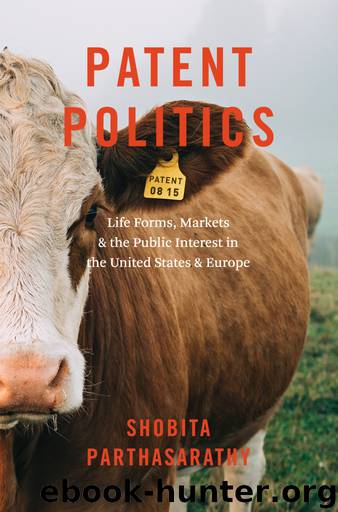Patent Politics by Shobita Parthasarathy

Author:Shobita Parthasarathy [Parthasarathy, Shobita]
Language: eng
Format: epub
ISBN: 978--0-226-43799--6
Publisher: University of Chicago Press
Published: 2017-01-10T05:00:00+00:00
Validation in the Courts
As the Edinburgh and WARF patent oppositions crawled along, Christoph Then (this time on behalf of Greenpeace) also challenged hESC patents through the national courts. Eventually these challenges arrived at the EU’s highest court, the European Court of Justice, which was potentially another source of pressure on the European patent system. In 1999, two years before the EPO granted the Edinburgh patent, the German Patent Office awarded Oliver Brüstle, a researcher at the University of Bonn and a vocal proponent of hESC research, a patent covering methods of deriving neural cells from hESCs.143 Greenpeace immediately opposed the decision, arguing that the patent violated the BPD. The German Patent Office revoked the patent; Brüstle filed for and received a modified patent; and Then and Greenpeace sued in 2004.144 The German federal court ruled in favor of Greenpeace, and Brüstle appealed the case to the German Supreme Court. The German Supreme Court referred the case to the ECJ, seeking clarification on several aspects of the BPD, including the meaning of “human embryos,” the meaning of the expression “uses of human embryos for industrial or commercial purposes” in the BPD (which by then was also figuring prominently in EPO’s decisions to deny the WARF patent and limit the Edinburgh patent), and whether the destruction of the human embryo matters for determining patentability if it is not explicitly discussed in the patent’s claims. Although Brüstle argued that the case jeopardized the future of hESC research in Europe, Then emphasized that his focus was on the commercialization of human embryos: “Even if research on embryos is to be allowed, it’s not right to commercialize the process. . . . We believe there should be a clear separation between research and patenting products.”145 To Then, the patent system had an important and distinct role to play in the governance of hESC research. Focusing regulatory attention on the research enterprise would not address the patents’ socioeconomic impacts or the moral impacts of turning hESCs into commodities.
In October 2011, the ECJ agreed with Greenpeace and echoed the EPO’s position. In its first decision on the patentability of life forms,146 Europe’s highest court defined a human embryo as any fertilized human ovum in which the “process of development of a human being” was taking place, and read the BPD to exclude patents on products and processes related to hESCs because they involved the “commercialization or exploitation” of a human embryo. It also decided that hESCs were unpatentable if they involved the destruction of an embryo, even if that destruction was not explicitly discussed in the patent claims. In making this decision, the ECJ relied heavily on the text of the BPD, especially the language in Article 6 that provided the basis for the EPO’s decisions in the Edinburgh and WARF cases.
The ECJ also reinforced the connection between the European right to human dignity and patent law, and therefore the patent system’s moral responsibilities. As discussed previously, while challengers had made this connection in the debates over the Edinburgh and WARF patents, the EPO had not justified its decisions explicitly in moral terms.
Download
This site does not store any files on its server. We only index and link to content provided by other sites. Please contact the content providers to delete copyright contents if any and email us, we'll remove relevant links or contents immediately.
2010-The City & the City by China Miéville(1527)
Anatomy of Injustice by Raymond Bonner(1273)
ADHD on Trial by Michael Gordon(1247)
That Every Man Be Armed by Stephen P. Halbrook(1244)
Injustices by Ian Millhiser(1204)
You Don't Own Me by Orly Lobel(1151)
Tell by Major Margaret Witt(1106)
A Vast Conspiracy by Jeffrey Toobin(1069)
Course Correction by Ginny Gilder(1054)
Broken Scales by Joel Cohen(1026)
J by Howard Jacobson(993)
First by Evan Thomas(992)
Without Copyrights by Spoo Robert(984)
The Run of His Life: The People v. O. J. Simpson by Jeffrey Toobin(966)
A Religious Orgy in Tennessee by H.L. Mencken(955)
A Triumph of Genius: Edwin Land, Polaroid, and the Kodak Patent War by Ronald K. Fierstein(911)
A History Of Thailand by Baker Chris(895)
Law 101: Everything You Need to Know About American Law, Fourth Edition by Jay Feinman(853)
John Wayne Gacy by Judge Sam Amirante(848)
